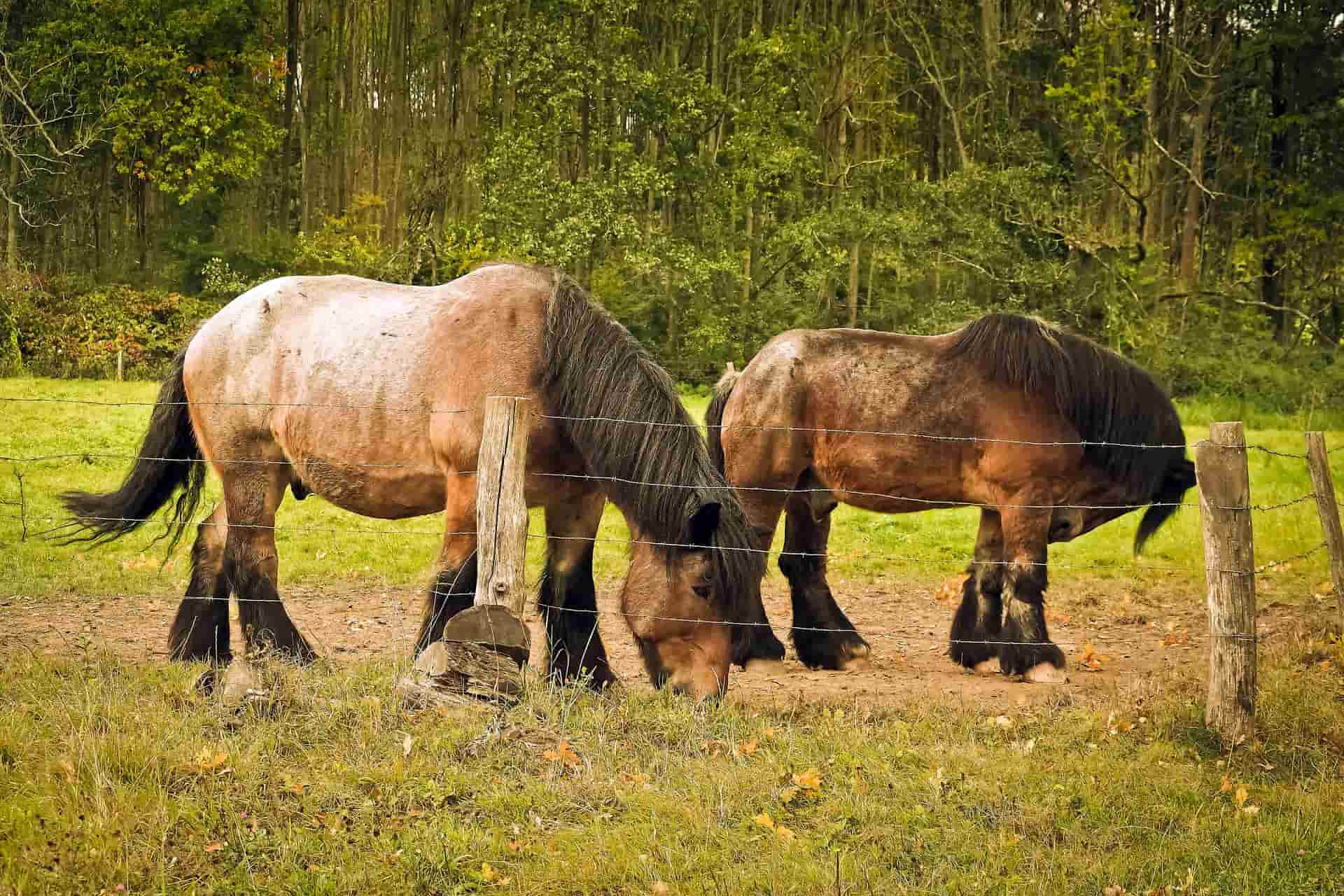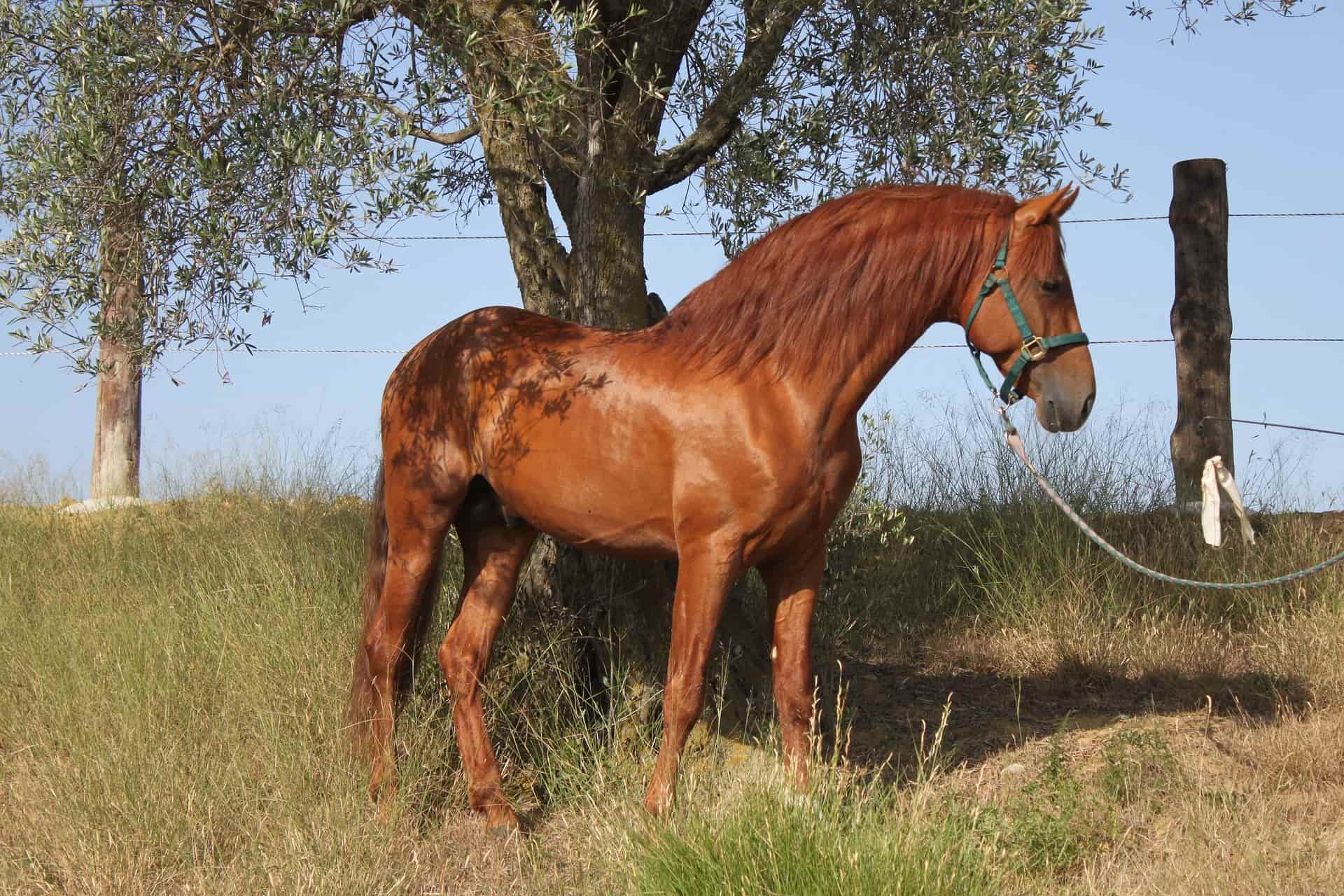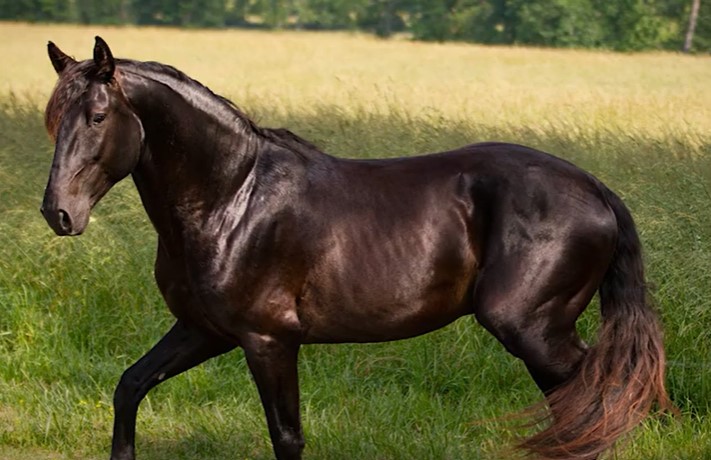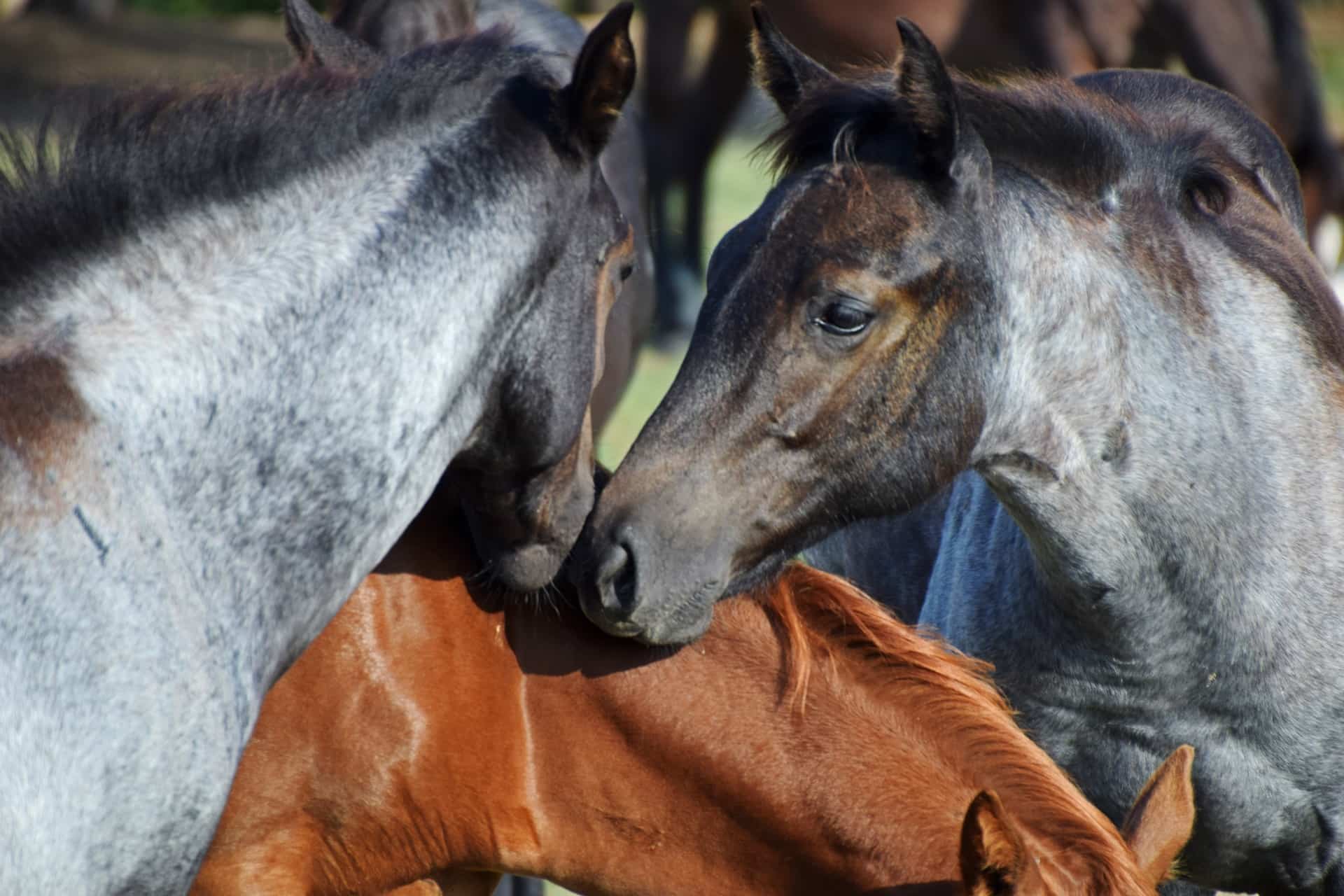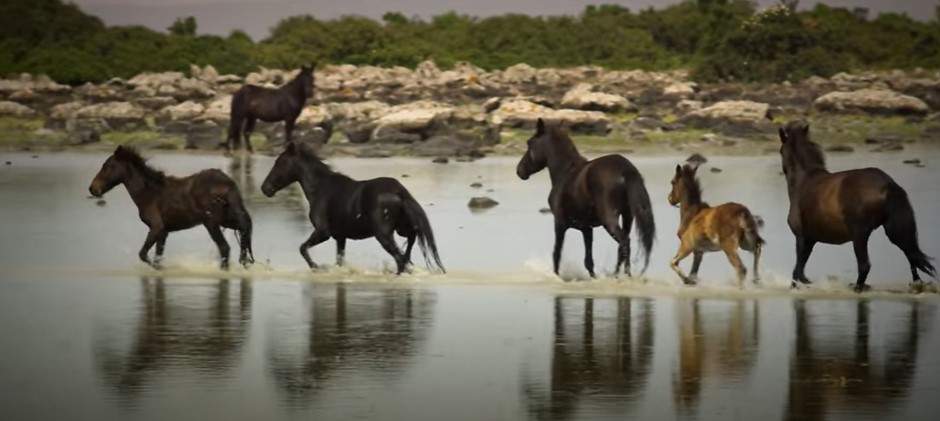The Ardennes horse has a history that spans across many centuries. These horses have been bred in the Ardennes plains throughout history.
They have also acted as a foundation bloodstock for other draft horses and equine breeds. The Trait Du Nord, Baltic Ardennes, and Russian Heavy Draft horse breeds all trace their roots to the Ardennes.
From first glance, you can tell that this horse is mighty and powerful- an aspect that makes it stand out from other horses. Factor in its docile temperament and you have a horse breed that’s perfect for working in small farms.
Despite its gigantic stature, the Ardennes’ temperament is humble and obedient. So whether you’re training or putting it to work, you’ll find it incredibly easy to work with.
Read on to learn everything you need to know about the Ardennes horse breed.
History and Evolution of the Ardennes Horse Breed
The Ardennes horse has a rich history that can be traced to Ancient Rome.
Legend has it that the breed originated from the horses that Julius Caesar reserved for use as cavalry mounts.
Still, others believe that the Ardennes was popular among knights who used it to pull heavy cavalry units in the Middle Ages. Another school of thought is that the Ardennes descends from the prehistoric Solutrean horse that’s now extinct.
Whether the Ardennes originates from the Solutre or horses owned by Julius Caesar remains a mystery. The one thing we’re sure of is that it was produced in the Ardennes area of Belgium, France (see some popular French horse breeds) and Luxembourg with the aim of using it for draft work.
The predecessors of this animal look pretty similar to what the Ardennes looks like now. However, there’s one big difference.
When the Ardennes horse was first developed in the Roman era, it was pretty small in size with an average height of just 52 inches. It also lacked the physique and endurance found in current Ardennes horses.
It wasn’t until the horse was crossbred with other breeds that it gained a bit of height. Both Roman Emperors and Napoleon introduced several bloodlines with the aim of creating strong horses suitable for the battlefield.
Breeders first introduced Arabian blood into this Belgian breed. This made a difference, albeit small. The Ardennes now averaged 14 to 15 hands (52 to 60 inches) and weighed roughly 1100 pounds.
A few years later, the Ardennes was cross-bred with other breeds such as the Percheron, Thoroughbred, and Boulonnais. However, the breed that had the greatest impact on the Ardennes transformation was the Belgian Draft horse.
It was crossbred with the Ardennes in the 19th century, resulting in a horse that was not only heavier but also taller and stronger.
Given how successful this selective breeding was, Napoleon went on to use these draft horses for his Russian campaign. Unlike other horse breeds, Ardennes horses were able to withstand the rough terrain and harsh weather conditions of Russia.
Napoleon isn’t the only ruler who used them as war horses. French and Belgian armies used these animals to pull artillery during world war i and world war ii.
When breeders introduced the Belgian horse, their aim was to create a heavy draft breed, and they certainly achieved this.
Introducing Belgian blood increased its weight to a whopping 1500 pounds. In fact, it’s not unusual to find Ardennes horses that weigh up to 2,200 pounds.
Learn: How Much Do Horses Weigh?
With the adoption of mechanization in the agricultural sector, the Ardennes was no longer useful as an artillery horse.
Rather, it was more useful as a draft horse that could be used for other heavy-duty tasks. But as time went by, even its role as a heavy draft breed diminished. As a result, the Ardennes horse was primarily used for meat production.
The Modern Day Ardennes Horse
The very first breed registry was established back in 1929 in Europe.
The Ardennes Horse Society of Great Britain was also founded towards the end of the 20th century. The main reason behind its creation was to preserve and promote Ardennes horses throughout Great Britain. Sadly, it’s no longer recognized as a studbook by the British Government.
Given that the Ardennes horse originated from the Ardennes region, it’s no wonder it spread in European countries fast.
The Ardennes breed was only imported into the United States in the early 20th century.
When these horses were first shipped into the U.S., they qualified for registration with the French Draft Horse Society. This is because Most of the Ardennes horses imported into this nation were considered to be ‘French Draft” breed.
However, there are a couple that were considered to be Belgians; hence, listed as Belgian Ardennes.
Throughout history, Ardennes horses have continued to be imported into the U.S. particularly from Belgium.
Currently, there are three separate studbooks for this breed. There’s one in Belgium, another in France and the last one in Luxembourg. Although each of these registries has its own policy, there’s extensive breeding among all three.
Also interesting to note is that the present Ardennes is used in the development of other draft breeds. These include the Russian Heavy Draft, Baltic Ardennes and Swedish Ardennes.
The Trait Du Nord and Sokolsky horse breeds also have the Ardennes blood coursing through their veins.
So what is the present-day Belgian Ardennes used for? Interestingly, this breed remains highly sought after for its meat, particularly in European countries like Switzerland, France and Germany.
In other parts of the world, the Ardennes horse is revered for its strength. This breed’s strength is what makes it so good for forestry and farm work.
This breed showcases exceptional ability to work in hilly terrain. Still other horse owners prefer to use this breed for competitive driving due to its calm nature.
Characteristics of the Ardennes Horse Breed
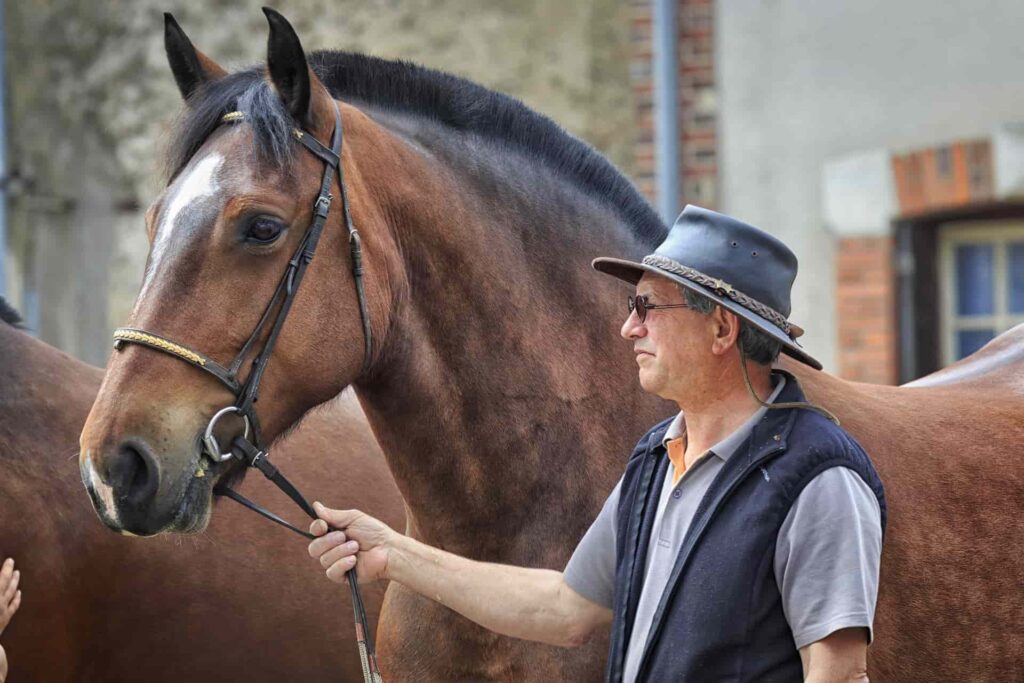
Size and Weight
The height of Ardennes horses varies slightly depending on whether it’s a stallion or mare. Ardennes stallions are typically taller, averaging 64 inches. Meanwhile, the mares are about 61 inches tall.
Learn: The Average Horse Heights (How to Measure)
When it comes to weight, this ranges between 1,500 and 2,200 pounds. Other notable features of the Ardennes include a broad head with a somewhat convex profile and feathered fetlocks.
And despite having a compact body and short back, they have a heavier conformation. They have robust legs with very strong joints (shouldn’t be needing any equine joint supplements for a while with this breed).
Also worth mentioning is that the Ardennes horses mature early. And they’re easy keepers, making them a low-maintenance breed.
Colors
Ardennes horses come in a variety of colors, including chestnut, bay, gray, roan and palomino. However, the two most common ones are bay and roan colored horses.
Although rare, you may also find this horse in a black shade. However, this color isn’t approved for registration. If you look keenly, you’ll also notice tiny star-shaped white markings on this horse, making it somewhat a black and white breed.
Temperament
Ardennes horses are quite a big breed with a weight of up to 2200 pounds. Due to their size, many assume that they’re bad-tempered.
On the contrary, these horses have a surprisingly docile nature. So much so that they’ve earned the title “gentle giants.” Ardennes horses are tolerant, and kindhearted.
This explains why they were used as cavalry mounts in the past and continue to make excellent mounts for kids and beginners.
How to Care for an Ardennes Horse
Ardennes horses are usually described as easy keepers so you won’t struggle taking care of these draft horses.
With proper care, the Ardennes horse can live for anywhere between 25 and 30 years.
Learn: How Long Does a Horse Live?
Here’s what you need to do when it comes to caring for this horse breed.
Diet
Compared to other draft breeds, the Ardennes horse is among the easiest to care for. Being a hardy breed, it can live on lower-quality forage.
However, because it likes to forage in any area that has rich pasture, you’ll need to pay great attention to their consumption levels. Otherwise, these horses can easily overfeed and gain excessive weight.
Grooming
One other issue that you should pay careful attention to is the breed’s grooming. In particular, practice currying every once in a while. This not only helps to loosen dirt but it also enhances the shine and glossiness of their coats.
To add to this, the Ardennes horse has heavy feathering on its fetlocks. If this feathering gets damp or muddy, your horse may experience skin irritation. To avoid this, consider braiding or grooming this feathering.
Common Health Issues
The Ardennes horse is susceptible to the same health problems that affect other draft breeds. These include:
- Equine polysaccharide storage myopathy (EPSM)
- Shivers
- Azoturia
Cost of the Ardennes
The cost of an Ardennes horse varies significantly. However, the minimum you can expect to spend is $2,500.
Important to note is that Ardennes horses aren’t very common. Due to limited supply, it’s not unusual to find some selling for up to $5,000. While not the most expensive horse breed, not the cheapest breed either.
If you’re ready to take the plunge, keep in mind that you’ll incur more costs and not just the initial purchase price. Grooming, feeding and sheltering the Ardennes horse are all aspects that require money.
FAQs
How much does an Ardennes horse cost?
The price of Ardennes horses ranges between $2,500 and $5,000.
Conclusion
Originally, the Ardennes were bred as war horses. But they evolved significantly and they’re now used in an array of disciplines.
Its muscular physique makes it perfectly suited for forestry and agricultural work. Meanwhile, its friendly and calm temperament is admired by many jockeys who use it for competitive driving.
That said, the Ardennes horse requires thorough grooming to ensure it lives a long and healthy life. Specifically, pay attention to the feathering that crops up on their fetlocks and hooves. Be sure to groom or braid the feathering to keep it from getting wet and dusty.
